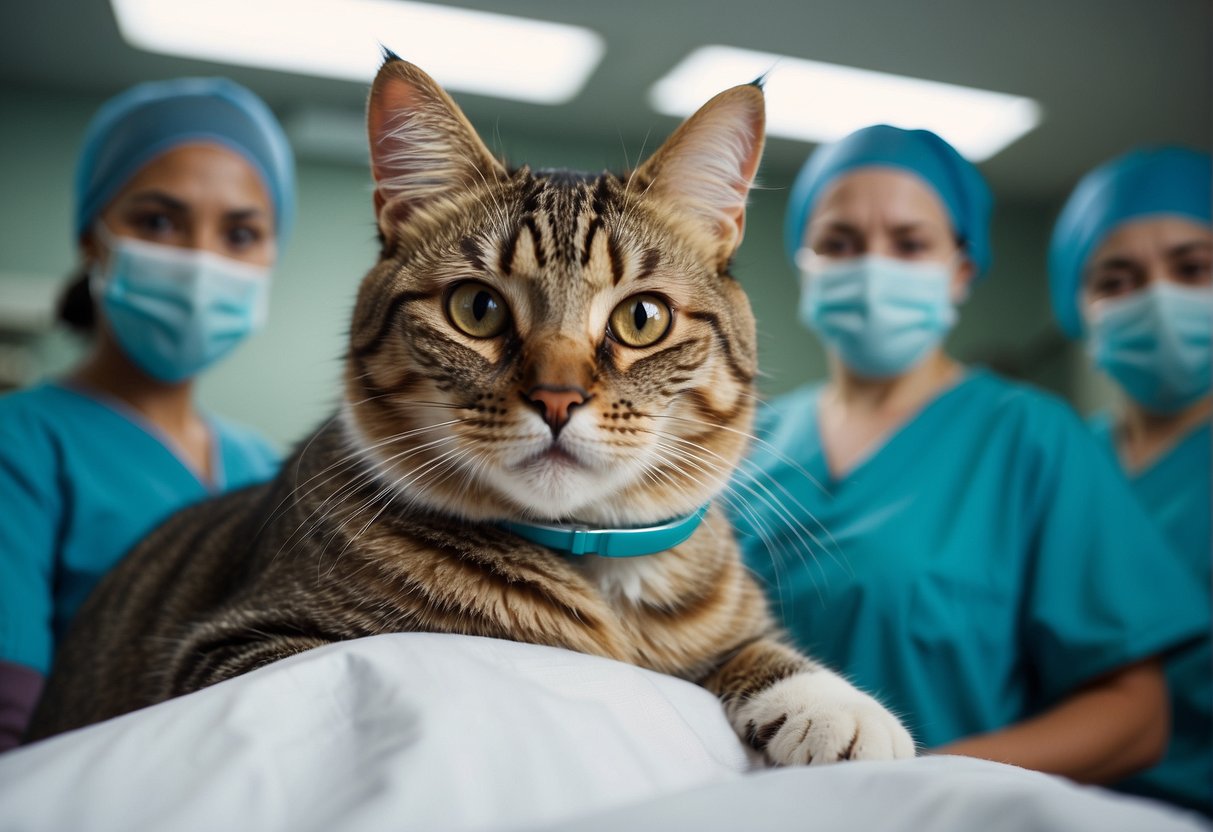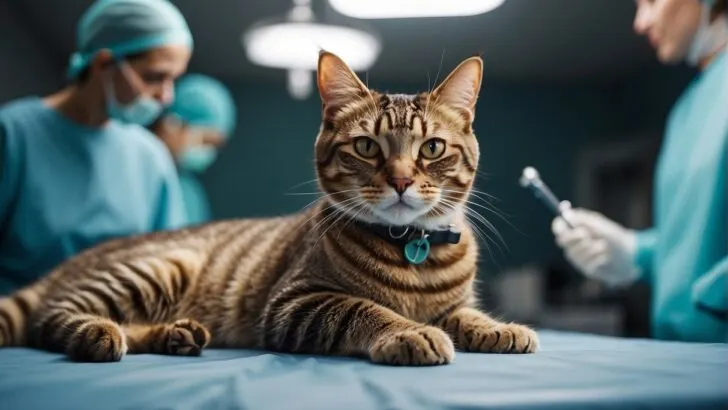The cost of a cesarean section for a cat, typically an emergency procedure to safely remove kittens from the uterus, can vary widely. Based on veterinary practices, you might expect to see prices ranging from $400 to $1,600 in the United States and Canada.
Factors such as the urgency of the surgery and the specific conditions of the birth can influence the cost.
For instance, if a cat is having a difficult labor that threatens the health of the kittens or the mother, a veterinarian may determine that an emergency c-section is necessary, and these urgent situations can lead to higher costs due to the additional resources and staff required.

If you’ve ever witnessed the miracle of kittens being born, you know that while nature often takes its course smoothly, complications can and do arise. A reputable veterinarian is your partner in ensuring the health and safety of your beloved cat and her offspring during these critical moments.
Researching and budgeting for the possibility of a surgical birth is a responsible step as a pet parent.
Understanding C-Sections for Cats

When your pregnant cat is unable to deliver her kittens naturally, a cesarean section, commonly known as a C-section, becomes a vital procedure to ensure the health and safety of both the mother and her offspring.
Reasons for a Cesarean Section
A C-section is a surgical procedure often seen as an emergency intervention during a difficult birth. If your cat is having an excessively long labor or if the kittens are positioned improperly, a cesarean section may be necessary. F
actors like the breed of your cat can also play a role; for instance, breeds with larger head sizes may present more difficulties during natural birth, increasing the likelihood of requiring a C-section.
Common reasons for a C-section include:
- Dystocia: The medical term for difficult labor, often due to the size or positioning of the kittens.
- Fetal Distress: If a kitten is in distress, immediate action is required to prevent harm.
- Maternal Health Issues: Conditions like uterine fatigue or a narrow pelvis can prevent a natural birth.
Pre-Surgical Considerations
Before your cat undergoes a C-section, several pre-surgical assessments are essential for a smooth procedure and her safety. An accurate diagnosis to confirm the need for a cesarean section will often involve diagnostic imaging such as X-rays or ultrasounds.
Here’s what to expect before the procedure:
- Anesthesia: Your cat will be given anesthesia to ensure she is pain-free and immobile during the surgery. It’s critical to have a trained professional administer and monitor the anesthesia.Keep in mind that like any surgery involving anesthesia, there are inherent risks involved.
- Emergency Preparedness: Since C-sections can be an emergency procedure, having a veterinarian you trust, who can swiftly perform a cesarean, could be a lifesaver.An emergency C-section can save the lives of your cat and her kittens, so understanding the signs of labor difficulties is key.
By understanding the complexities of cesarean sections for cats and the conditions that may warrant this intervention, you’re better prepared to support your feline friend should the need arise.
The Surgical Procedure
Your veterinarian will take every precaution to ensure the safety and well-being of your cat and her unborn kittens throughout the anesthesia, surgery, and recovery process.
Anesthesia and Surgery Process
To prepare your cat for a cesarean section, your veterinarian will administer anesthesia to ensure she is unconscious and free from pain during the procedure. Once anesthetized, the vet will make a surgical incision in the abdomen to gain access to the uterus.
The process requires precision and gentleness to safely extract the kittens. Each kitten is usually removed swiftly to minimize the time they spend without oxygen.
After all the kittens are delivered, the vet will suturethe incisions closed with either absorbable stitches or ones that’ll need removal after healing.
Post-Surgical Recovery and Monitoring
Post-surgery, both your cat and her newborns will need close monitoring during the recovery period. Your cat may experience swelling at the surgical site and will typically be given painkillers and antibiotics to manage discomfort and prevent infection.
It’s crucial to ensure that mama cat doesn’t disturb the incision area. An e-collar might be necessary to prevent licking or biting at the stitches. The kittens may spend time in an incubator if they need help maintaining body warmth.
Complications and Cat Care Post C-Section
After your cat undergoes a Cesarean section, monitoring her recovery and understanding possible complications is essential for her well-being. It’s a delicate time, not just for her, but for the newborn kittens as well.
Common Complications and How to Spot Them
Symptoms to watch for post-surgery:
- Bloody Vaginal Discharge: Some discharge is normal, but if it persists beyond a week, changes color, or has an odor, it’s a sign of a possible infection.
- Fever and Straining: Indicators of complications like uterine contraction issues or pyometra, an infection of the uterus.
- Excessive Bleeding: This can be a sign of internal complications and may accompany shock; watch for pale gums and lethargy.
Monitoring your cat’s temperature and general behavior is crucial. Any signs of distress, such as a lack of interest in the kittens or not returning to normal activities, warrant immediate veterinary attention.
Home Care and Preventative Measures
Your cat will need a quiet, comfortable space to recover and nurse her kittens. Here’s how you can help:
- Nursing and Milk Production:
- Ensure she is nursing and the kittens are feeding correctly to stimulate milk production and uterine contraction; this helps with her recovery.
- Oxytocin injections might be prescribed by your vet to aid with milk let-down and contraction of the uterus.
- Managing Infection Risks:
- Keep the incision clean and dry to prevent infection.
- Regularly check the incision site for swelling, redness, or discharge.
- Dystocia Prevention in Future Pregnancies:
- Discuss with your vet about the risks of future pregnancies, especially if the C-section was due to dystocia (difficult labor).
- Aftercare for Neuter:
- If your cat was neutered during the procedure, follow specific aftercare to avoid complications at both surgical sites.
Cost Considerations
When faced with the possibility of a Cesarean section for your precious feline, understanding the financial aspect is crucial. From the initial estimate, which can be quite a surprise, to the role of pet insurance, let’s explore what factors into the cost.
Estimating the Price of a Cat C-Section
The price of a C-section for your cat typically depends on several variables, including emergency situations and the presence of complications during pregnancy. A standard C-section can range from $400 to $1,600. In an emergency, this cost can surge to $3,000-$4,000, owing to the urgency and additional care required.
- Diagnostic procedures: such as x-rays or ultrasounds, may add $200-$500 to the overall cost.
- Surgery cost will include anesthesia, the surgical team’s expertise, and post-operative care.
Recovery period care, such as antibiotics or pain management, can add to the tally. Remember that the cost may vary significantly depending on the severity of the situation and the veterinary clinic.
Understanding Pet Insurance Options
With the high costs associated with veterinary surgery, particularly spaying or intricacies of an unplanned C-section, having pet insurance might alleviate some of the financial strain.
- Pet insurance plans can differ, so check if they cover elective procedures like spay or neuter surgeries, or emergency situations that require a C-section.
- Some plans may offer partial coverage or reimbursement after meeting a deductible, while others might not cover pregnancy-related issues at all.

My name is James, and welcome to FAQCats!
Along with our team of cat owners, expert pet enthusiasts, and pet professionals, we aim to write engaging helpful, engaging content about cats. At FAQCats we strive to provide content that’s accurate and fun to read. Our team writes about everything related to cats; even the most complex of topics. Through extensive research and caring for our own fur-pals, we’re able to provide something cat owners worldwide will love. Have a look around, and leave us feedback anytime!

